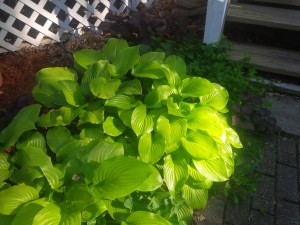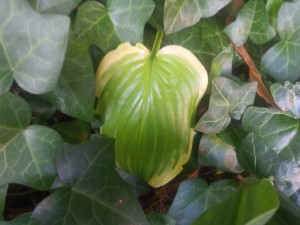
Everyone I know grows hostas. They are unparalleled for filling up space in shady spots and will increase happily, as long as you remember to put out Tony Soprano-style contracts on the local slugs and deer.
Some gardeners, who have made the appropriate slug and deer arrangements, might call hostas “the perfect plant.” Perfect, that is, if you aren’t fond of flowers. Typical hosta blooms are smallish, purplish trumpets that appear in summer atop gawky, nearly-naked stems that generally seem too tall for the plants. Fastidious gardeners clip off the stems, choosing to glory in the leaves and forget about the flowers. This hardly seems fair, since the flowers, despite their relative insignificance, provide sustenance for pollinators.
I am not that fastidious. However, I do remedy the ugly-blossom problem by choosing fragrant hostas to help fill up my lightly shaded areas.
Though they are less well-known than their unscented relatives, fragrant hostas—Hosta plantaginea and its offspring—are commercially available if you know where to look. They are old-fashioned garden plants with lots of nicknames, including August lily, Corfu lily, white plantain lily, white daylily, Japan lily and funkia. August lily is the most common, as well as the most appropriate, because the plants generally bloom in early August. As for the other nicknames, I am not sure what Hosta plantaginea has to do with Corfu. All hostas used to go by the generic name “funkia”, but they are not and never have been daylilies, which belong to a different plant family. Unlike most traditional hostas, which are descended from plants native to Japan, members of the plantaginea species descend from Chinese hostas.
There are over fifty, allegedly fragrant varieties, but according to plantsman and nursery owner, Tony Avent, fewer than thirty of those are truly fragrant and genetically stable, not to mention commercially available. Hosta plantaginea is a progenitor of all of them. If you are starting a fragrant hosta collection, this species form is the place to begin. It grows about twenty inches tall, with glossy, medium green leaves. The flowers are white without even a tinge of lavender and may be up to six inches long. Unlike the flimsy blooms of other hostas, August lilies are more lily-like–waxy in texture and substantial. Some writers describe the fragrance as being as sweet and pervasive as honeysuckle. Plantaginea flowers open in the late afternoon, so you can enjoy them after work. They are also attractive to local hummingbirds and make great cut flowers, if you can stand to bring them indoors.
If you are paging through catalog offerings in search of sweet-smelling hostas or surveying out-of-bloom plants in the nursery, look for names that start with the word “fragrant”. Like other hostas, plantaginea varieties and hybrids feature a number of leaf colors. Some have golden-green or variegated foliage as well, which adds interest in months other than August. The large-leafed variety, ‘Fragrant Bouquet’, is an award winner with medium green leaves edged in cream. Left to its own devices, it may grow up to forty-eight inches wide. The tasty sounding ‘Fried Bananas’ features the same fragrant white flowers as its plantaginea relatives, but also boasts golden-green leaves.

Lovers of blue-leafed hostas may choose ‘Ambrosia’, which features blue leaf edges and a glaucous or slightly frosted coating on the foliage. It is a big-leafed variety that may expand to a muscular fifty-four inches wide.
A few fragrant varieties also bear purple-shaded flowers. Little ‘Sugar Babe’, at only ten inches tall and sixteen inches wide, is one of them. It sports a thin white margin on each leaf edge and pale purple blooms. True to its name, ‘Sugar Babe’ is a natural for smaller garden spaces or containers.
My experience with August lilies has been excellent, with one exception—‘Venus’. This gorgeous plant features very large, fully double white flowers with a divine smell—or at least that’s what I hear. In my own garden’ Venus’ leafs out nicely and forms buds, but only blooms about once every five years. To say the plant is finicky is an understatement. If weather, temperature, humidity and the alignment of the planets are not just right, ‘Venus’ will sulk and refuse to open her petals. It is almost a relief when this goddess is nibbled by Mr. Antlers. At least then I don’t have to explain why it has failed to bloom yet again.
If you are one of the few gardeners burdened with too much sunny space, take heart. Plantaginea hostas tolerate more sun than other types. Many of them, in fact, flower better with less shade. If you have a hosta bed that is shaded on one end and sunny on the other, use the plantagineas to fill the sunny end.
Whatever you do, position the plants where they can be appreciated for their beautiful flowers and divine scent. If we had still had outhouses, they would be a perfect border for the path to the privy. Since most of us have moved beyond that, plant your August lilies near paths, under frequently-opened windows or adjacent to sitting areas.
Find your plantaginea varieties and hybrids at specialty retailers. One good supplier is New Hampshire Hostas, 73 Exeter Road, South Hampton, NH 03827, (603) 879-0085, www.nhhostas.com. Another wonderful source of hostas and all kinds of unusual plants is Plant Delights Nursery, 9241 Sauls Road, Raleigh, NC 27603, (919) 772-4794, www.plantdelights.com. The print catalog is available for an unusual price–ten first class stamps or a box of chocolates.
